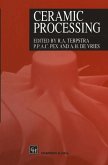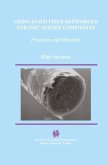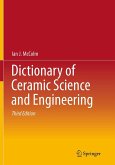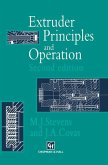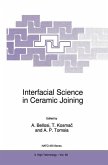- Gebundenes Buch
- Merkliste
- Auf die Merkliste
- Bewerten Bewerten
- Teilen
- Produkt teilen
- Produkterinnerung
- Produkterinnerung
Ceramic Processing is the first comprehensive, stand alone, multi-authored book on advanced ceramic processing. It provides an overview of the important processing steps involved in the fabrication of advanced ceramics for structural and functional applications.
Andere Kunden interessierten sich auch für
![Ceramic Processing Ceramic Processing]() Ceramic Processing115,99 €
Ceramic Processing115,99 €![The Art of Ceramic Extrusion The Art of Ceramic Extrusion]() Frank HändleThe Art of Ceramic Extrusion83,99 €
Frank HändleThe Art of Ceramic Extrusion83,99 €![Oxide-Based Fiber-Reinforced Ceramic-Matrix Composites Oxide-Based Fiber-Reinforced Ceramic-Matrix Composites]() Bilge SaruhanOxide-Based Fiber-Reinforced Ceramic-Matrix Composites77,99 €
Bilge SaruhanOxide-Based Fiber-Reinforced Ceramic-Matrix Composites77,99 €![Extruder Principles and Operation Extruder Principles and Operation]() M.J. StevensExtruder Principles and Operation168,99 €
M.J. StevensExtruder Principles and Operation168,99 €![Dictionary of Ceramic Science and Engineering Dictionary of Ceramic Science and Engineering]() Ian J. McColmDictionary of Ceramic Science and Engineering152,99 €
Ian J. McColmDictionary of Ceramic Science and Engineering152,99 €![Extruder Principles and Operation Extruder Principles and Operation]() M.J. StevensExtruder Principles and Operation168,99 €
M.J. StevensExtruder Principles and Operation168,99 €![Interfacial Science in Ceramic Joining Interfacial Science in Ceramic Joining]() Interfacial Science in Ceramic Joining113,99 €
Interfacial Science in Ceramic Joining113,99 €-
-
-
Ceramic Processing is the first comprehensive, stand alone, multi-authored book on advanced ceramic processing. It provides an overview of the important processing steps involved in the fabrication of advanced ceramics for structural and functional applications.
Produktdetails
- Produktdetails
- Verlag: Springer / Springer Netherlands
- Artikelnr. des Verlages: 978-0-412-59830-2
- 1995.
- Seitenzahl: 236
- Erscheinungstermin: 31. Juli 1995
- Englisch
- Abmessung: 241mm x 160mm x 18mm
- Gewicht: 492g
- ISBN-13: 9780412598302
- ISBN-10: 0412598302
- Artikelnr.: 24540229
- Herstellerkennzeichnung
- Springer-Verlag GmbH
- Tiergartenstr. 17
- 69121 Heidelberg
- ProductSafety@springernature.com
- Verlag: Springer / Springer Netherlands
- Artikelnr. des Verlages: 978-0-412-59830-2
- 1995.
- Seitenzahl: 236
- Erscheinungstermin: 31. Juli 1995
- Englisch
- Abmessung: 241mm x 160mm x 18mm
- Gewicht: 492g
- ISBN-13: 9780412598302
- ISBN-10: 0412598302
- Artikelnr.: 24540229
- Herstellerkennzeichnung
- Springer-Verlag GmbH
- Tiergartenstr. 17
- 69121 Heidelberg
- ProductSafety@springernature.com
1 Special ceramics for modern applications: which? why? how?.- 1.1 Introduction.- 1.2 Predictions arising from simple considerations of strength.- 1.3 Materials predictions based on equation (1.16).- 1.4 Some predictions based on fracture toughness.- 1.5 The size and shape of materials needed for processing.- 1.6 Prediction of limiting particle size arising from mechanical grinding.- 1.7 Combination of ultrafine ceramic powders and fibres: ceramic-ceramic composites.- 1.8 Relative costs.- 1.9 Self-propagating high-temperature synthesis (SHS).- References.- 2 Laser vapour phase synthesis of ceramic powders.- 2.1 Introduction.- 2.2 Experimental aspects.- 2.3 Results.- 2.4 Discussion.- 2.5 Conclusions.- References.- 3 Particle interactions in suspensions.- 3.1 Introduction.- 3.2 Surface forces.- 3.3 Behaviour of suspensions.- 3.4 Controlling interparticle forces.- 3.5 Some examples.- References.- 4 Dry pressing of ceramic powders.- 4.1 Introduction.- 4.2 Industrial problems.- 4.3 Macroscopic behaviour: the classical approach.- 4.4 Macroscopic behaviour: the mechanical approach.- 4.5 Microscopic behaviour.- 4.6 Conclusions.- Appendix: Tensor notation for stress.- References.- 5 The principles of tape casting and tape casting applications.- 5.1 Introduction.- 5.2 The doctor blade tape process.- 5.3 Subsequent processing of unfired tapes.- References.- 6 Plastic forming of ceramics: extrusion and injection moulding.- 6.1 Introduction to extrusion.- 6.2 Formulation principles.- 6.3 Mixing.- 6.4 Soil mechanics.- 6.5 The extrusion process.- 6.6 Additional topics.- 6.7 Introduction to injection moulding.- 6.8 Detailed discussion of the process.- 6.9 New approaches to forming complex shapes.- References.
1 Special ceramics for modern applications: which? why? how?.- 1.1 Introduction.- 1.2 Predictions arising from simple considerations of strength.- 1.3 Materials predictions based on equation (1.16).- 1.4 Some predictions based on fracture toughness.- 1.5 The size and shape of materials needed for processing.- 1.6 Prediction of limiting particle size arising from mechanical grinding.- 1.7 Combination of ultrafine ceramic powders and fibres: ceramic-ceramic composites.- 1.8 Relative costs.- 1.9 Self-propagating high-temperature synthesis (SHS).- References.- 2 Laser vapour phase synthesis of ceramic powders.- 2.1 Introduction.- 2.2 Experimental aspects.- 2.3 Results.- 2.4 Discussion.- 2.5 Conclusions.- References.- 3 Particle interactions in suspensions.- 3.1 Introduction.- 3.2 Surface forces.- 3.3 Behaviour of suspensions.- 3.4 Controlling interparticle forces.- 3.5 Some examples.- References.- 4 Dry pressing of ceramic powders.- 4.1 Introduction.- 4.2 Industrial problems.- 4.3 Macroscopic behaviour: the classical approach.- 4.4 Macroscopic behaviour: the mechanical approach.- 4.5 Microscopic behaviour.- 4.6 Conclusions.- Appendix: Tensor notation for stress.- References.- 5 The principles of tape casting and tape casting applications.- 5.1 Introduction.- 5.2 The doctor blade tape process.- 5.3 Subsequent processing of unfired tapes.- References.- 6 Plastic forming of ceramics: extrusion and injection moulding.- 6.1 Introduction to extrusion.- 6.2 Formulation principles.- 6.3 Mixing.- 6.4 Soil mechanics.- 6.5 The extrusion process.- 6.6 Additional topics.- 6.7 Introduction to injection moulding.- 6.8 Detailed discussion of the process.- 6.9 New approaches to forming complex shapes.- References.


